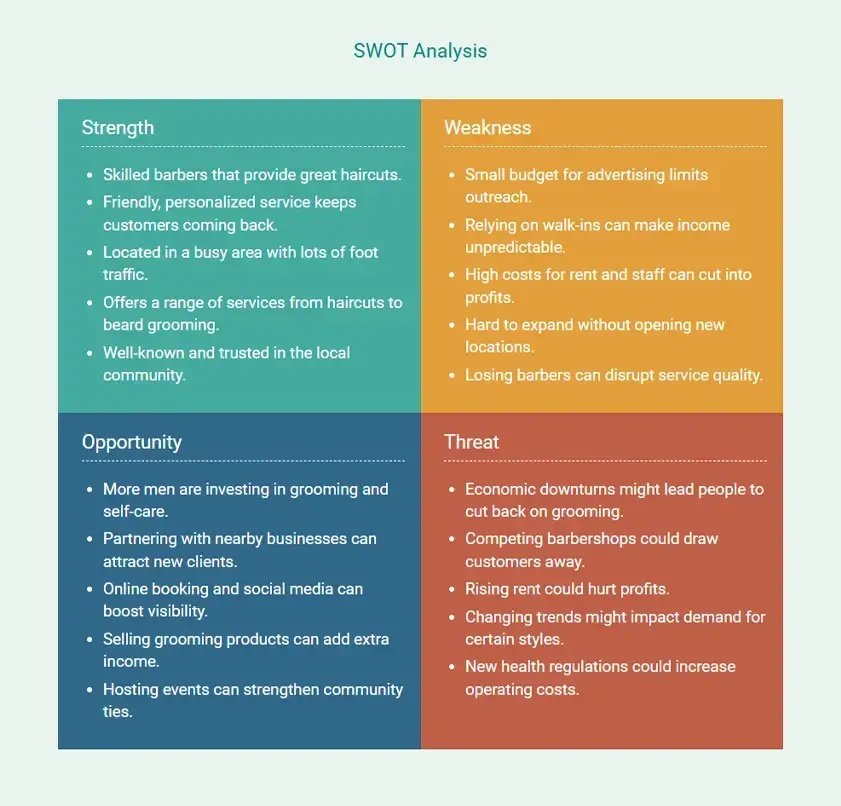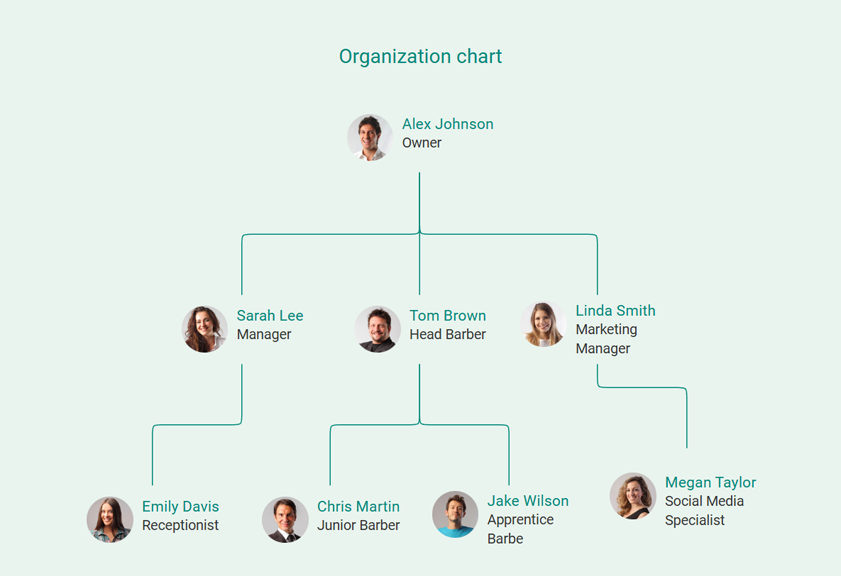Opening your own barbershop can be a thriving venture if you’ve got a knack for great haircuts and shaves.
But writing a business plan might feel like a big hurdle, especially when you’re just starting out! Even Lauren Carrillo, the owner of Bruce's Barbershop in California, felt the same.
I recently had a conversation with Lauren about her journey of starting and running a successful shop that’s always buzzing with clients.
From those insights, I’ve prepared this easy-to-follow guide on writing a barber shop business plan for your help and inspiration right away.
What is a barbershop business plan?
A barbershop business plan is basically a professional, living document that serves as a strategic roadmap for starting and growing your own barbershop.
It covers every aspect of your business, including the types of services you’ll offer, target market, potential clients, marketing plan, operational intricacies, detailed financial forecast analysis, as well as startup costs.
In short, writing a good business plan helps you stay focused while guiding you through each stage of your entrepreneurial journey.
How to write a barbershop business plan?
Preparing your barbershop business plan requires careful attention to various key components and sections that define your business concept, goals, and strategies. Here’s a detailed guide:
1. Executive summary
Think of your executive summary as the elevator pitch—providing a quick, well-rounded snapshot of your entire barber shop business plan.
Though it’s the first section, you should consider writing it at the very end once the entire doc is ready. This is so because it summarizes all the essential key elements mentioned in the rest of your plan.
Here’s what to include in this section:
- Your shop’s name, location, and concept
- Mission statement
- Main services you’ll offer (like haircuts, shaves, and beard trims)
- Target market
- Marketing plan
- Financial projections and goals
Overall, your business plan executive summary highlights what your barber shop business is all about and helps you grab the potential investors’ attention. So, keep it clear, concise, and compelling.
“Writing the executive summary for my Barbershop turned out to be a real balancing act. I wanted to really nail down what makes the shop special—it's got that classic, old-school barber shop feel where you actually know your barber, but with a modern twist.
We’re all about creating a space where everyone feels welcome, whether you’re coming in for a classic cut or a fresh fade.
It took a while to put that into words in a way that didn’t sound like every other barbershop out there. But I eventually found a way to make it feel real and true to what Bruce’s is all about."—Lauren
2. Business overview
In this section, you have to dive deeper into the details of your barber shop. Cover everything from its basic information to the foundational facts that clearly define the WHY behind your business.
Start drafting with the essentials, such as the registered name of your barber shop, its location, and the reason for choosing that place.
Then, shed light on your long-term vision and the type of business legal structure you’ve selected (e.g., limited liability company, partnership, sole proprietorship). If applicable, mention your shop’s background history and its opening date or timeline.
In addition to that, describe what sets you apart from other barber shops in the area and explain why customers will choose your shop over others.
“One challenge that really stood out was defining what made us different in a sea of barbershops.
Initially, I found myself struggling to pinpoint our unique angle. Every barbershop offers cuts and shaves, so how could we truly stand out?
The breakthrough came when I shifted focus from just our services to the experience we aimed to create. I started thinking about how we could blend the timeless charm of a traditional barbershop with modern touches."—Lauren
3. Services and pricing strategies
Now, it’s time to list out all the services you’re going to offer and even think about how you’ll price them. Make sure you clearly describe each service, so that potential customers know exactly what they’ll get.
For example, your service offerings might include:
- Basic haircuts
- Skin fades
- Beard trims
- Hot towel shaves
- Kids’ cuts
- And many more.
While devising this section, try to do some research and explore what other barber shops in your area charge. In order to that, set a competitive pricing strategy—don’t price yourself out of the market or don’t undersell yourself.
You may also consider including membership plans, seasonal packages, or special discounts for repeat customers. It’s a great way to keep clients coming back.
“Beyond the basics, I wanted to offer enough options to attract a wide range of clients, but I didn’t want a huge list of services that would be hard to manage.
So, I started talking to some regulars from my old shop, asking them what they wished their barbers offered.
A lot of them mentioned they were looking for a solid hot towel shave or a good beard trim—things they couldn’t get at the chain shops."—Lauren
4. Industry and market research
Well, it’s very important to understand the grooming industry and the local market in which your barber business intends to operate.
Conducting detailed market research will help you get valuable insights into the target customers, key competitors, and salon industry trends as well as build a strong foundation for your barbershop.
Here’s a list of components that you need to research and include in your plan:
Industry size & its growth
Begin by outlining the current market size of the barber shop industry and its growth potential. For instance:
“By the end of 2024, the barber shop industry revenue is projected to reach $5.8 billion, showing high consumer demand for quality personal care and grooming services.”
This will give you an insight into the overall demand and future opportunities within the male grooming sector.
Target market
Who are your potential customers, and what are they looking for in a barbershop? Are you targeting busy professionals, families, or college students?
Plus, find out their needs and preferences as well as how much they’re willing to pay for a haircut. It helps you create a “customer persona” that represents your ideal client.
Competitive analysis
Identify the key competitors in your area, including other barber shops, beauty & hair salons, etc. Visit them if you can, and take note of their strengths and weaknesses.
Summarize what their customers love and where they fall short. This will allow you to find your own unique angle.
“At first, I thought I’d just be competing with other barbershops, but I quickly realized I had to include places like hair salons and chains like Great Clips too.
Even though they don’t have that classic barbershop vibe I’m going for, they’re still cutting hair, right?
So, I spent some time visiting those spots, checking out their services and prices, and reading reviews to see what customers liked and what they complained about.
It took a while, but it helped me see where Bruce’s could stand out."—Lauren
Market trends and opportunities
Is there a growing interest in beard grooming or luxury shaves in your area? Are more people looking for barbershops that offer online booking?
Identify trends that could shape your services and marketing approach. Use these insights to set a position for your shop in a way that fills a need in the market.
5. SWOT analysis
SWOT stands for Strengths, Weaknesses, Opportunities, and Threats.
Perform an effective SWOT analysis to identify your internal strengths and weaknesses, as well as external opportunities and threats in the external market. Here’s an example:

This enables you to stay realistic about what you’ll face as you get started and develop robust strategies for the future.
“It’s one of those things that sounds simple—listing out strengths, weaknesses, opportunities, and threats—but once I got into it, I realized how much thought it actually takes.
It’s easy to focus on the good stuff—like our great location near a busy coffee shop or the fact that we offer quality services.
Then there were the weaknesses or threats, I had to look at things I wasn’t excited to admit—it wasn’t as fun.
But it forces me to come up with solutions and really think about how to set my Bruce’s Barber Shop apart."—Lauren
6. Sales and marketing strategy
Next, work on your sales and marketing strategies that can let you promote your barber shop in front of the target audience.
This can help you attract customers, retain existing ones, and eventually drive revenue. Here are a few marketing tactics and methods for barber shops:
- Building a strong online presence through website and social media platforms
- Utilizing local advertising or promotions
- Participating in local community events
- Using email marketing campaigns
- Networking or partnering with influencers or local businesses
- Running targeted online Google Ads
- Organizing workshops for hair styling services or grooming tips
While in your sales plan, discuss your sales goals and targets, along with the promotional techniques, like upselling and cross-selling of additional services or retail products, loyalty programs, and word of mouth referral incentives.
“If I had to give advice, I’d say find out where your clients are and focus on those channels. And don’t be shy about gathering customer feedback—it makes a huge difference when people are searching for a new place.
Plus, a little discount for new clients can bring in a steady stream of new faces without making you feel like you’re giving away too much."—Lauren
7. Management team
Management team section of business plan highlights key people responsible for running your barber shop smoothly and making it a success.
If it’s just you, include a section about yourself and share your background experience in the barbering landscape. Further, talk about passion and how you came to open your shop.
If you have a small team of barbers, jot down their roles and responsibilities, educational qualifications, and work experience, illustrating how each member fits their roles. Also, build an organization chart to define your management structure and decision-making hierarchy.

Moreover, you can mention your advisory board members (if any) that can add credibility to your business idea.
“We’re a small team, which is great because we’re close-knit and can adjust quickly, but it also means we need a plan if the business really starts booming.
So, I put together a hiring plan for bringing in more barbers down the line and how I’d focus more on managing if that happened.
It showed that we’re not just thinking about right now, but also how we’d keep things running smoothly as we grow."—Lauren
8. Financial plan
The financial plan is all about numbers (money!) and yes it’s an integral part.
Typically, your barber shop financial plan involves a comprehensive analysis of your financial projections for the next 3-5 years. This will give your barber shop’s financial viability and sustainability over time.
The following are a few critical financial statements and reports you must cover in your plan:
- Startup costs
- Sales forecast and revenue growth
- Operating expenses
- Income statement (profit and loss statement)
- Cash flow statement
- Balance sheet
- Break-even analysis
Furthermore, you should estimate the funding needs (if applicable), use of funds, loan repayment methods, and most importantly devise strategies for potential financial risks while running your shop.
“Creating the financial plan for Bruce’s Barbershop turned out to be way more complicated than I thought.
I kept running into extra costs I hadn’t considered—like cleaning supplies, booking software, and even coffee for clients. Every time I thought I had it figured out, something new would pop up.
After a few late nights and endless tweaks, I tried using financial forecasting software. I thought it might be overkill, but it ended up being a game-changer.
It let me test different scenarios—like a busy week versus a slow one—and automatically adjusted the numbers, saving me a ton of time and stress."—Lauren
Download our barber shop business plan template
So, ready to write your barber shop business plan from scratch? But need more assistance with that? No worries; download our free barber shop business plan template in PDF to make things easier.
This advanced template has helped thousands of entrepreneurs start their businesses effectively. I hope it helps you as well. With its real-life examples and insights, you’ll be able to build a successful business plan that impresses investors.
Conclusion
Summing up! With the help of this comprehensive business plan guide and a free template, you’re now well-equipped to draft your very own plan.
However, if you find yourself feeling stuck or have confusion regarding the details, consider talking to the best business plan consultant out there. They’ll provide expert-level guidance and help you fine-tune your business plans as well.
So, wait no longer; make a call and plan for your first barbershop!
Frequently Asked Questions
What are the sources of funding for the barber shop business?
If you want to secure funding for your barber shop, consider these financing sources:
- Personal savings
- Traditional bank or SBA loans
- Angel investors
- Government grants
- Crowdfunding platforms like Kickstarter or GoFundMe
Are there any examples or templates for a barber shop business plan?
Yes, there are plenty of business plan examples and templates available for a barber shop. Websites like Upmetrics, Bizplanr, LivePlan, and Bplans offer free as well as paid templates, guiding you to structure your barber shop business plan.
How much detail should I include in the financial section of my business plan?
Your business plan’s financial section must be as detailed as possible, and make sure it gives a clear picture of your business's financial health and projections. Here’s a breakdown of what to include:
- Initial startup costs
- Ongoing monthly expenses
- Monthly revenue from haircuts and other services
- Cash flow statement
- Profit and loss projections
- Break-even analysis
How much does it cost to write a barber shop business plan?
The total cost of writing a barber shop business plan can be as low as $7 (or even free) to as high as $25,000. It all depends on the method you choose to create a plan—do-it-yourself (DIY), hire a professional writer, or use a business planning app.

